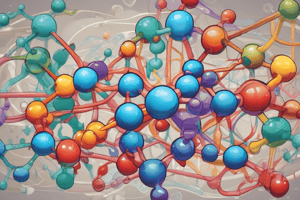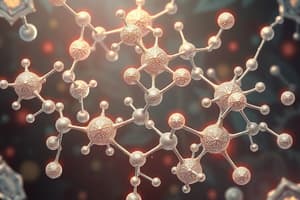Podcast
Questions and Answers
What are the building blocks of carbohydrates and name one example?
What are the building blocks of carbohydrates and name one example?
The building block of carbohydrates is monosaccharides, and an example is glucose.
What roles do phospholipids and cholesterol play in the cell?
What roles do phospholipids and cholesterol play in the cell?
Phospholipids compose the cell membrane, while cholesterol serves as a precursor for steroid hormones.
What is the primary function of ribosomes in a cell?
What is the primary function of ribosomes in a cell?
Ribosomes are responsible for making proteins.
Explain the difference between aerobic and anaerobic respiration.
Explain the difference between aerobic and anaerobic respiration.
What is the significance of the Golgi Apparatus in a cell?
What is the significance of the Golgi Apparatus in a cell?
Study Notes
### Carbohydrates
- The building block of carbohydrates is the monosaccharide glucose.
- Monosaccharides are single sugar units.
- Disaccharides are two sugar units.
- Polysaccharides are made up of many sugar units.
- Polysaccharides include glycogen, starch and fiber.
Lipids
- The building block of lipids is a fatty acid.
- Triglycerides are fats that store energy for the body.
- Phospholipids are important components of cell membranes.
- Steroids are lipids that function as important hormones.
### Proteins
- The building block of proteins are amino acids.
- Essential amino acids must be consumed through diet as the body cannot produce them.
- Proteins have a variety of important functions, including building and repairing tissues, enzymes, structure, and hormones.
### Nucleic Acids
- Nucleic acids store and deliver information in the body.
- The two types of nucleic acids are DNA and RNA.
- The building block of nucleic acids is a nucleotide.
### Cellular Structures
- The plasma membrane is the outer covering of a cell, composed primarily of phospholipids.
- The cytoplasm includes the cytosol and organelles.
- The nucleus contains DNA, the genetic material of the cell.
- The nucleolus is responsible for making ribosomes.
- Ribosomes are responsible for protein synthesis.
- The rough endoplasmic reticulum (ER) modifies proteins.
- The smooth ER is responsible for synthesizing carbohydrates and lipids.
- The Golgi apparatus packages and ships proteins.
- Mitochondria are responsible for energy production in the cell, using oxygen to generate ATP.
- Lysosomes break down bacteria and old organelles.
- Microvilli are small projections that increase surface area for absorption, found in the digestive tract.
- Cilia are hair-like projections that aid in movement, found in the respiratory tract.
- Flagella are tail-like projections that aid in movement, found in sperm cells.
### Cellular Processes
- Anabolism is the process of building up molecules.
- Catabolism is the process of breaking down molecules.
- Aerobic respiration occurs in the mitochondria with the presence of oxygen, producing a large amount of ATP, and releasing carbon dioxide as a byproduct.
- Anaerobic respiration occurs in the absence of oxygen, does not produce significant energy and results in the production of lactic acid.
- Ketones are waste products produced from the breakdown of fat.
- Urea is a waste product produced from the breakdown of protein.
### Cell Division
- Interphase is the period when the cell is performing its normal functions.
- Mitosis is a form of cell division where a single cell divides into two identical daughter cells, each with 46 chromosomes. This process is important for cell regeneration and growth.
Studying That Suits You
Use AI to generate personalized quizzes and flashcards to suit your learning preferences.
Description
This quiz covers the fundamental macromolecules: carbohydrates, lipids, proteins, and nucleic acids. It explores their building blocks, functions, and significance in biological systems. Test your knowledge on the basic structure and roles of these essential biomolecules.




